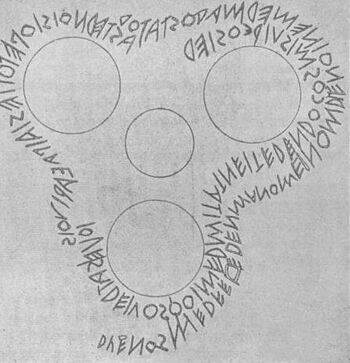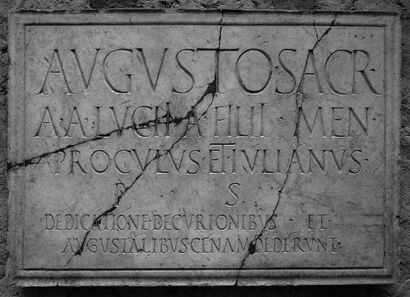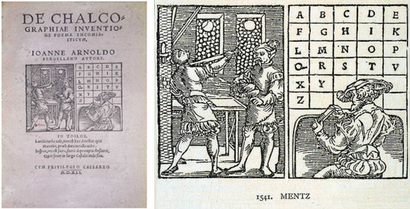الأبجدية اللاتينية
| الأبجدية اللاتينية Latin alphabet | |
|---|---|
 | |
| النوع | |
| اللغات | اللاتينية |
| الفترة الزمنية | ~700 ق.م. إلى الحاضر. |
النظم الوالدة | الهيروغليفية المصرية
|
النظم الابنة | Numerous Latin alphabets; also more divergent derivations such as Osage |
النظم الشقيقة | |
| الاتجاه | Left-to-right |
| ISO 15924 | Latn, 215 |
مرادف اليونيكود | Latin |
| See Latin characters in Unicode | |
 |
| فن الخط |
|---|
الأبجدية اللاتينية، وتُعرف أيضاً بإسم الأبجدية الرومانية، التي هي مجموعة من الحروف التي كان يستخدمها في الأصل الرومان القدماء لكتابة اللغة اللاتينية. Largely unaltered with the exception of additions (the letters ⟨J⟩, ⟨U⟩, and ⟨W⟩) and extensions (such as diacritics), it forms the Latin script that is used to write many modern European languages, including English and many modern Asian languages, including Malay, Indonesian and Modern Standard Syloti (MSS).[1] With modifications, it is also used for other alphabets, such as the Vietnamese alphabet. Its modern repertoire is standardised as the ISO basic Latin alphabet.
أصل الاسم
The term Latin alphabet may refer to either the alphabet used to write Latin (as described in this article) or other alphabets based on the Latin script, which is the basic set of letters common to the various alphabets descended from the classical Latin alphabet, such as the English alphabet. These Latin-script alphabets may discard letters, like the Rotokas alphabet, or add new letters, like the Danish and Norwegian alphabets. Letter shapes have evolved over the centuries, including the development in Medieval Latin of lower-case, forms which did not exist in the Classical period alphabet.
التطور
The Latin alphabet evolved from the visually similar Etruscan alphabet, which evolved from the Cumaean Greek version of the Greek alphabet, which was itself descended from the Phoenician alphabet, which in turn derived from Egyptian hieroglyphs.[2] The Etruscans ruled early Rome; their alphabet evolved in Rome over successive centuries to produce the Latin alphabet. During the Middle Ages, the Latin alphabet was used (sometimes with modifications) for writing Romance languages, which are direct descendants of Latin, as well as Celtic, Germanic, Baltic and some Slavic languages. With the age of colonialism and Christian evangelism, the Latin script spread beyond Europe, coming into use for writing indigenous American, Australian, Austronesian, Austroasiatic and African languages. More recently, linguists have also tended to prefer the Latin script or the International Phonetic Alphabet (itself largely based on the Latin script) when transcribing or creating written standards for non-European languages, such as the African reference alphabet.
العلامات والاختصارات
Although Latin did not use diacritical marks, signs of truncation of words (often placed above or at the end of the truncated word) were very common. Furthermore, abbreviations or smaller overlapping letters were often used. This was due to the fact that if the text was engraved on stone, the number of letters to be written was reduced, while if it was written on paper or parchment, it saved precious space. This habit continued even in the Middle Ages. Hundreds of symbols and abbreviations exist, varying from century to century.[3]
التاريخ
الأصول
It is generally believed that the Latin alphabet used by the Romans was derived from the Old Italic alphabet used by the Etruscans.[4] That alphabet was derived from the Euboean alphabet used by the Cumae, which in turn was derived from the Phoenician alphabet.[بحاجة لمصدر]
الأبجدية الإيطاليقية القديمة

| Letters | 𐌀 | 𐌁 | 𐌂 | 𐌃 | 𐌄 | 𐌅 | 𐌆 | 𐌇 | 𐌈 | 𐌉 | 𐌊 | 𐌋 | 𐌌 | 𐌍 | 𐌎 | 𐌏 | 𐌐 | 𐌑 | 𐌒 | 𐌓 | 𐌔 | 𐌕 | 𐌖 | 𐌗 | 𐌘 | 𐌙 | 𐌚 |
|---|---|---|---|---|---|---|---|---|---|---|---|---|---|---|---|---|---|---|---|---|---|---|---|---|---|---|---|
| Transliteration | A | B | C | D | E | V | Z | H | Θ | I | K | L | M | N | Ξ | O | P | Ś | Q | R | S | T | Y | X | Φ | Ψ | F |
الأبجدية اللاتينية العتيقة
| As Old Italic | 𐌀 | 𐌁 | 𐌂 | 𐌃 | 𐌄 | 𐌅 | 𐌆 | 𐌇 | 𐌉 | 𐌊 | 𐌋 | 𐌌 | 𐌍 | 𐌏 | 𐌐 | 𐌒 | 𐌓 | 𐌔 | 𐌕 | 𐌖 | 𐌗 |
|---|---|---|---|---|---|---|---|---|---|---|---|---|---|---|---|---|---|---|---|---|---|
| As Latin | A | B | C | D | E | F | Z | H | I | K | L | M | N | O | P | Q | R | S | T | V | X |
الأبجدية اللاتينية القديمة
Latin included 21 different characters. The letter ⟨C⟩ was the western form of the Greek gamma, but it was used for the sounds /ɡ/ and /k/ alike, possibly under the influence of Etruscan, which might have lacked any voiced plosives. Later, probably during the 3rd century BC, the letter ⟨Z⟩ – not needed to write Latin properly – was replaced with the new letter ⟨G⟩, a ⟨C⟩ modified with a small vertical stroke, which took its place in the alphabet. From then on, ⟨G⟩ represented the voiced plosive /ɡ/, while ⟨C⟩ was generally reserved for the voiceless plosive /k/. The letter ⟨K⟩ was used only rarely, in a small number of words such as Kalendae, often interchangeably with ⟨C⟩.
| الحرف | A | B | C | D | E | F | Z | G | H | I | K | L | M | N | O | P | Q | R | S | T | V | X |
|---|
الأبجدية اللاتينية الكلاسيكية
After the Roman conquest of Greece in the 1st century BC, Latin adopted the Greek letters ⟨Y⟩ and ⟨Z⟩ (or readopted, in the latter case) to write Greek loanwords, placing them at the end of the alphabet. An attempt by the emperor Claudius to introduce three additional letters did not last. Thus it was during the classical Latin period that the Latin alphabet contained 21 letters and 2 foreign letters:
| الحرف | A | B | C | D | E | F | G | H | I | K | L | M | N | O | P | Q | R | S | T | V | X | Y | Z |
|---|---|---|---|---|---|---|---|---|---|---|---|---|---|---|---|---|---|---|---|---|---|---|---|
| الاسم اللاتيني (majus) | á | bé | cé | dé | é | ef | gé | há | ꟾ | ká | el | em | en | ó | pé | qv́ | er | es | té | v́ | ix | ꟾ graeca | zéta |
| النقحرة | ā | bē | cē | dē | ē | ef | gē | hā | ī | kā | el | em | en | ō | pē | qū | er | es | tē | ū | ix | ī Graeca | zēta |
| النطق اللاتيني (IPA) | aː | beː | keː | deː | eː | ɛf | ɡeː | haː | iː | kaː | ɛl | ɛm | ɛn | oː | peː | kuː | ɛr | ɛs | teː | uː | iks | iː ˈɡraɪka | ˈdzeːta |

The Latin names of some of these letters are disputed; for example, ⟨H⟩ may have been called [ˈaha] or [ˈaka].[5] In general the Romans did not use the traditional (Semitic-derived) names as in Greek: the names of the plosives were formed by adding /eː/ to their sound (except for ⟨K⟩ and ⟨Q⟩, which needed different vowels to be distinguished from ⟨C⟩) and the names of the continuants consisted as a rule either of the bare sound, or the sound preceded by /e/.
The letter ⟨Y⟩ when introduced was probably called "hy" /hyː/ as in Greek, the name upsilon not being in use yet, but this was changed to i Graeca ("Greek i") as Latin speakers had difficulty distinguishing its foreign sound /y/ from /i/. ⟨Z⟩ was given its Greek name, zeta. This scheme has continued to be used by most modern European languages that have adopted the Latin alphabet. For the Latin sounds represented by the various letters see Latin spelling and pronunciation; for the names of the letters in English see English alphabet.
Diacritics were not regularly used, but they did occur sometimes, the most common being the apex used to mark long vowels, which had previously sometimes been written doubled. However, in place of taking an apex, the letter i was written taller: ⟨á é ꟾ ó v́⟩. For example, what is today transcribed Lūciī a fīliī was written ⟨lv́ciꟾ·a·fꟾliꟾ⟩ in the inscription depicted. Some letters have more than one form in epigraphy. Latinists have treated some of them especially such as ⟨Ꟶ⟩, a variant of ⟨H⟩ found in Roman Gaul.
The primary mark of punctuation was the interpunct, which was used as a word divider, though it fell out of use after 200 AD.
Old Roman cursive script, also called majuscule cursive and capitalis cursive, was the everyday form of handwriting used for writing letters, by merchants writing business accounts, by schoolchildren learning the Latin alphabet, and even emperors issuing commands. A more formal style of writing was based on Roman square capitals, but cursive was used for quicker, informal writing. It was most commonly used from about the 1st century BC to the 3rd century, but it probably existed earlier than that. It led to Uncial, a majuscule script commonly used from the 3rd to 8th centuries AD by Latin and Greek scribes. Tironian notes were a shorthand system consisting of thousands of signs.
New Roman cursive script, also known as minuscule cursive, was in use from the 3rd century to the 7th century, and uses letter forms that are more recognizable to modern eyes; ⟨a⟩, ⟨b⟩, ⟨d⟩, and ⟨e⟩ had taken a more familiar shape, and the other letters were proportionate to each other. This script evolved into a variety of regional medieval scripts (for example, the Merovingian, Visigothic and Benevantan scripts), to be later supplanted by the Carolingian minuscule.
التطور في العصور الوسطى وما بعدها
It was not until the Middle Ages that the letter ⟨W⟩ (originally a ligature of two ⟨V⟩s) was added to the Latin alphabet, to represent sounds from the Germanic languages which did not exist in medieval Latin, and only after the Renaissance did the convention of treating ⟨I⟩ and ⟨U⟩ as vowels, and ⟨J⟩ and ⟨V⟩ as consonants, become established. Prior to that, the former had been merely allographs of the latter.[بحاجة لمصدر]
With the fragmentation of political power, the style of writing changed and varied greatly throughout the Middle Ages, even after the invention of the printing press. Early deviations from the classical forms were the uncial script, a development of the Old Roman cursive, and various so-called minuscule scripts that developed from New Roman cursive, of which the insular script developed by Irish literati and derivations of this, such as Carolingian minuscule were the most influential, introducing the lower case forms of the letters, as well as other writing conventions that have since become standard.
The languages that use the Latin script generally use capital letters to begin paragraphs and sentences and proper nouns. The rules for capitalization have changed over time, and different languages have varied in their rules for capitalization. Old English, for example, was rarely written with even proper nouns capitalized, whereas Modern English writers and printers of the 17th and 18th century frequently capitalized most and sometimes all nouns,[6] e.g. in the preamble and all of the United States Constitution: We the People of the United States, in Order to form a more perfect Union, establish Justice, insure domestic Tranquility, provide for the common defence, promote the general Welfare, and secure the Blessings of Liberty to ourselves and our Posterity, do ordain and establish this Constitution for the United States of America. This is still systematically done in modern German.
انظر أيضاً
- Latin spelling and pronunciation
- Calligraphy
- Euboean alphabet
- Latin script in Unicode
- ISO basic Latin alphabet
- Latin-1
- Legacy of the Roman Empire
- Palaeography
- Phoenician alphabet
- Pinyin
- Roman letters used in mathematics
- Typography
- Western Latin character sets (computing)
- Spread of the Latin script
المراجع
- ^ "Sylheti language and the Syloti-Nagri alphabet". www.omniglot.com. Retrieved 2024-03-08.
- ^ Michael C. Howard (2012), Transnationalism in Ancient and Medieval Societies. p. 23.
- ^ Cappelli, Adriano (1990). Dizionario di Abbreviature Latine ed Italiane. Milano: Editore Ulrico Hoepli. ISBN 88-203-1100-3.
- ^ "Etruscan alphabet | Etruscan Writing, Ancient Scripts & Language". Britannica (in الإنجليزية). Retrieved 2023-10-17.
- ^ Liberman, Anatoly (7 August 2013). "Alphabet soup, part 2: H and Y". Oxford Etymologist. Oxford University Press. Retrieved 3 October 2013.
- ^ Crystal, David (4 August 2003). The Cambridge Encyclopedia of the English Language. Cambridge University Press. ISBN 9780521530330 – via Google Books.
للاستزادة
- Jensen, Hans (1970). Sign Symbol and Script. London: George Allen and Unwin Ltd. ISBN 0-04-400021-9. Transl. of Jensen, Hans (1958). Die Schrift in Vergangenheit und Gegenwart. Deutscher Verlag der Wissenschaften., as revised by the author
- Rix, Helmut (1993). "La scrittura e la lingua". In Cristofani, Mauro (hrsg.) (ed.). Gli etruschi – Una nuova immagine. Firenze: Giunti. pp. S.199–227.
- Sampson, Geoffrey (1985). Writing systems. London (etc.): Hutchinson.
- Wachter, Rudolf (1987). Altlateinische Inschriften: sprachliche und epigraphische Untersuchungen zu den Dokumenten bis etwa 150 v.Chr. Bern (etc.).: Peter Lang.
- Allen, W. Sidney (1978). "The names of the letters of the Latin alphabet (Appendix C)". Vox Latina – a guide to the pronunciation of classical Latin. Cambridge University Press. ISBN 0-521-22049-1.
- Biktaş, Şamil (2003). Tuğan Tel.
وصلات خارجية
| مراجع مكتبية عن Latin alphabet |
| الأبجدية اللاتينية المعاصرة الأساسية | |||||||||||||||||||||||||
|---|---|---|---|---|---|---|---|---|---|---|---|---|---|---|---|---|---|---|---|---|---|---|---|---|---|
| Aa | Bb | Cc | Dd | Ee | Ff | Gg | Hh | Ii | Jj | Kk | Ll | Mm | Nn | Oo | Pp | Rr | Ss | Tt | Uu | Vv | Ww | Xx | Yy | Zz | |
|
التاريخ • علم الخطاطة • المشتقات • التشكيل • punctuation • الأرقام • يونيكود • قائمة الحروف • ISO/IEC 646 | |||||||||||||||||||||||||
- Short description is different from Wikidata
- Scripts with ISO 15924 four-letter codes
- Articles with hatnote templates targeting a nonexistent page
- Articles with unsourced statements from November 2019
- Articles containing لاتينية-language text
- Articles with unsourced statements from July 2018
- Latin script
- Typography
- History of the Roman Empire
- أبجديات

